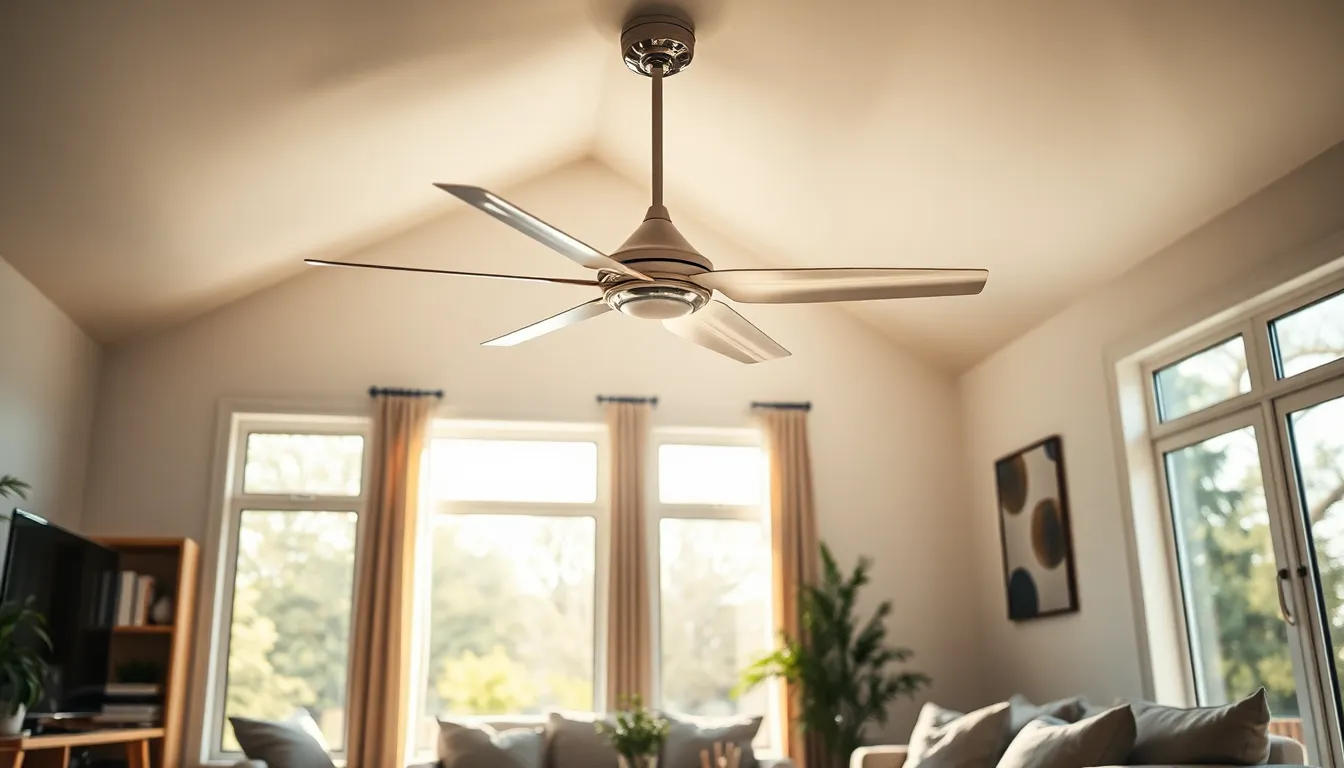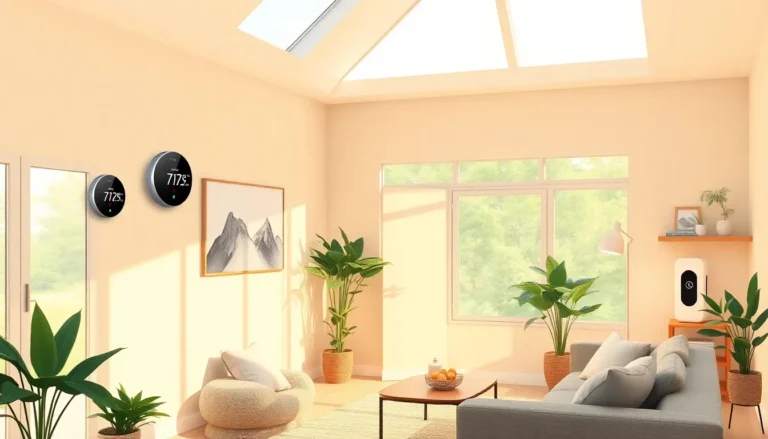Imagine walking into a room and having the perfect breeze greet you, just like a loyal butler who knows your every whim. Automated fan control isn’t just a luxury; it’s the modern-day equivalent of having your own personal air maestro. Gone are the days of wrestling with clunky switches and remote controls. With automated systems, fans adjust to your comfort level, keeping you cool while you binge-watch your favorite shows or tackle that mountain of paperwork.
But wait, it gets better! These smart systems can even learn your habits and preferences. So whether it’s a hot summer day or a cozy winter evening, your fan is always ready to deliver that ideal airflow without you lifting a finger. Dive into the world of automated fan control and discover how it can transform your space into a climate-controlled paradise, all while saving energy and keeping your sanity intact.
Table of Contents
ToggleOverview of Automated Fan Control
Automated fan control enhances comfort by adjusting airflow based on real-time data. Smart systems monitor environmental conditions like temperature and humidity. These systems also adapt to user patterns, learning individual preferences over time.
Energy savings stand out as a major benefit of automated fan control. Traditional manual fans often run unnecessarily, consuming power even when not needed. By contrast, automated systems optimize fan operation, only running when conditions warrant larger airflow.
Convenience adds to the appeal of these technologies. Instead of manually adjusting fan settings, users rely on smart systems to maintain ideal climates. Many automated fan controllers integrate with home automation platforms, providing seamless user experience.
Numerous features further enhance the functionality of automated fan control. Sensors can detect room occupancy, ensuring airflow only when people are present. Scheduling options enable users to define specific times for increased airflow, allowing for customized comfort.
Quality of life improves significantly with automated fan control systems. Homes experience consistent temperatures, fewer hot or cold spots, and improved air circulation. Such systems contribute to overall well-being, making living spaces more pleasant.
Automated fan control stands out for its efficiency, convenience, and impact on comfort. These systems ultimately reshuffle how individuals engage with their indoor environment. Employing advanced technology eliminates the need for manual adjustments, providing a more adaptive living experience.
Benefits of Automated Fan Control

Automated fan control offers numerous advantages that enhance living spaces and promote comfort. These systems integrate smart technology to manage airflow efficiently and effectively.
Energy Efficiency
Energy efficiency stands out as a significant benefit of automated fan control. Smart fans adapt to temperature changes and user habits, ensuring they operate only when necessary. This optimization reduces energy consumption compared to traditional models. According to studies, homes equipped with automated fans can save up to 30% on energy bills. Sensors detect occupancy, activating fans in occupied spaces while remaining off in unoccupied areas. This functionality not only cuts costs but also supports environmentally friendly practices.
Improved Comfort
Improved comfort becomes a reality with automated fan control systems. These fans adjust airflow based on real-time environmental data, such as temperature and humidity. Users experience a consistent and pleasant climate, regardless of weather changes. Personalized settings allow fans to maintain preferred conditions throughout the day. Scheduling options enable fans to operate during peak hours of discomfort, promoting a restful environment. The ability to learn user patterns enhances the overall experience, creating a climate that feels just right.
Noise Reduction
Noise reduction plays a crucial role in the benefits of automated fan control. Traditional fans often produce disruptive sounds that can hinder relaxation or concentration. Automated models utilize advanced technology to operate quietly while maintaining airflow. Many systems include settings designed to minimize noise during operation, ensuring a peaceful atmosphere. Users can enjoy consistent comfort without the distraction of loud machinery. This focus on noise control significantly elevates the quality of life in homes and workplaces.
Types of Automated Fan Control Systems
Automated fan control systems come in various types, each designed for specific environmental conditions. These systems enhance comfort while managing energy efficiency.
Temperature-Based Control
Temperature-based control systems operate by adjusting fan speed according to the temperature in a given space. Sensors detect changes and activate fans when temperatures exceed preset thresholds. This proactive approach maintains a comfortable environment. Many models allow users to set desired temperature ranges, optimizing airflow patterns accordingly. Such efficiency leads to consistent indoor comfort while reducing energy consumption.
Humidity-Based Control
Humidity-based control systems monitor moisture levels in the air, automatically regulating fan operation to maintain ideal humidity levels. Increased humidity often leads to discomfort and mustiness. By using hygrometers, these systems effectively reduce humidity through increased air circulation. Users experience fresher air, and excess moisture is minimized. This operation promotes a healthier living space, free from mold or mildew issues.
Hybrid Systems
Hybrid systems combine both temperature and humidity controls, providing a comprehensive solution for indoor air management. These systems adapt to both heat and moisture variations, reacting intelligently to changing conditions. Enhanced control over both factors results in a consistently pleasant environment. With technology advancements, hybrid systems are increasingly efficient and user-friendly, contributing to overall energy savings. Users benefit from seamless integration into any living space, ensuring optimal comfort year-round.
Applications of Automated Fan Control
Automated fan control systems find utility in various environments, ranging from homes to large industrial facilities. Each application showcases the effectiveness of these systems in enhancing air quality and comfort.
Residential Use
Automated fan control in residential settings improves overall living conditions. Homeowners benefit from smart fans adjusting speeds based on temperature and humidity levels. Data shows that homes equipped with automated fans can save up to 30% on energy expenses. Additionally, these systems provide personalized comfort by responding to occupancy, ensuring fans only operate when needed. Many users appreciate the noise reduction feature, allowing for a serene environment while maintaining optimal airflow.
Commercial Use
In commercial spaces, automated fan control enhances energy efficiency and productivity. Businesses utilize these systems to regulate climate, improving air quality for employees and customers alike. According to studies, workplaces with automated systems report increased comfort levels, contributing to higher employee satisfaction and performance. Occupancy sensors optimize fan use, reducing operational costs while maintaining a pleasant atmosphere. Many offices benefit from programmable schedules, aligning airflow with working hours, thereby supporting energy conservation.
Industrial Use
Industrial settings implement automated fan control for crucial heat management and ventilation. Factories and warehouses utilize these systems to monitor air quality, ensuring compliance with safety regulations. Processes involving high temperatures demand effective cooling, and automated fans offer solutions through continuous adjustments based on real-time conditions. Studies indicate that proactive fan control can enhance equipment lifespan by preventing overheating. Additionally, systems tailored for industrial applications promote a safer work environment by reducing harmful airborne particles.
Challenges in Implementing Automated Fan Control
Implementing automated fan control presents several challenges. One significant hurdle involves integrating these systems with existing HVAC configurations. Many older setups lack the necessary infrastructure to support smart technology, leading to increased installation costs.
Another challenge is ensuring compatibility with various sensor types. Different environments may require specific sensors for optimal operation. This complexity can complicate system design and increase resource demands.
User acceptance poses another obstacle. Consumers may hesitate to trust automated systems, fearing reliability issues. Educating users on the benefits and functionality of automated fan control helps alleviate concerns, increasing adoption rates.
Data security is also a concern. Smart systems often rely on internet connectivity, making them vulnerable to cyber threats. Implementing robust security measures becomes essential to protect user information and maintain system integrity.
Cost factors can be significant as well. Initial investment for automated fan control systems may deter potential users. Although these systems can lead to energy savings, upfront expenses often require justification.
Maintaining usability remains critical. Systems must accommodate varying user preferences and habits, providing intuitive controls. Failure to address usability risks user frustration and decreased satisfaction.
Installation processes can also be complex and time-consuming. Skilled professionals are often required to ensure proper setup and calibration. This adds to the overall expense and may delay implementation.
Addressing these challenges is vital for maximizing the benefits of automated fan control. Strategic planning and careful consideration of each aspect lead to more effective and user-friendly solutions.
Automated fan control stands as a transformative solution for enhancing comfort and energy efficiency in various environments. By intelligently adjusting airflow based on real-time data and user preferences, these systems create a personalized atmosphere that promotes well-being. The ability to save energy while maintaining optimal air quality makes automated fan control an appealing choice for homeowners and businesses alike.
Despite some implementation challenges, the benefits far outweigh the hurdles. As technology continues to advance, the integration of automated fan control systems will become increasingly seamless. Embracing these innovations not only leads to a more comfortable living space but also supports sustainable practices, making it a smart investment for the future.








